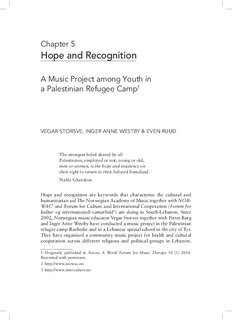| dc.contributor.author | Storsve, Vegar | |
| dc.contributor.author | Westby, Inger Anne | |
| dc.contributor.author | Ruud, Even | |
| dc.date.accessioned | 2013-11-29T07:28:39Z | |
| dc.date.available | 2013-12-01T00:04:07Z | |
| dc.date.issued | 2012 | |
| dc.identifier.citation | I: Educating music teachers in the new millennium, s. 69-88 | no_NO |
| dc.identifier.isbn | 978-82-7853-075-7 | |
| dc.identifier.issn | 0333-3760 | |
| dc.identifier.uri | http://hdl.handle.net/11250/172385 | |
| dc.description.abstract | Hope and recognition are keywords that characterize the cultural and humanitarian aid The Norwegian Academy of Music together with NORWAC2 and Forum for Culture and International Cooperation are doing in South-Lebanon. Since 2002, Norwegian music educator Vegar Storsve together with Petter Barg and Inger Anne Westby have conducted a music project in the Palestinian refugee camp Rashedie and in a Lebanese special school in the city of Tyr. They have organized a community music project for health and cultural cooperation across different religious and political groups in Lebanon. This article will describe parts of this work and discuss how such a music project may have consequences for development and health promotion among children and young people in refugee camps. The authors have their background in music education and music therapy. However, this project was conceived as a music educational project. with the growth of community music and community music therapy, we find reasons to discuss this project as a prototypical community music project. The explicit health aspect and the influence from community music therapy also open a discussion about the borders between these areas of practice. What creates a strong link between the two approaches is the underlying theory of “community of practice”, which will be discussed below (see Wenger, 1998; Ansdell, 2010). The questions raised in this article concern to what extent a music project can strengthen a sense of self and identity, as well as the experience of belonging to one’s own traditions among Palestinian youth. Further, how is it possible to organize a music project that gives possibilities for musical learning and personal growth? And how can such a project afford new role models and responsibilities that may give hope for a better future? | no_NO |
| dc.language.iso | eng | no_NO |
| dc.publisher | Norges musikkhøgskole | no_NO |
| dc.relation.ispartofseries | NMH-publikasjoner;2012:7 | |
| dc.subject | music therapy | no_NO |
| dc.subject | youth | no_NO |
| dc.subject | refugees | no_NO |
| dc.subject | community music project | no_NO |
| dc.subject | music education | no_NO |
| dc.title | Hope and recognition. A music project among youth in a Palestinian refugee camp | no_NO |
| dc.type | Chapter | no_NO |
| dc.type | Peer reviewed | no_NO |
| dc.subject.nsi | VDP::Humanities: 000::Musicology: 110::Music pedagogics: 114 | no_NO |
| dc.source.pagenumber | S. 69-88 | no_NO |
